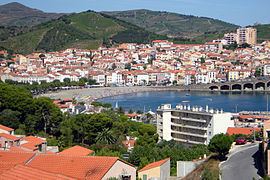Canton Côte Vermeille Population 4,644 (2007) | Region Occitanie Area 42.43 km² Local time Thursday 4:28 AM | |
 | ||
Intercommunality Communauté de communes des Albères et de la Côte Vermeille Weather 9°C, Wind N at 6 km/h, 82% Humidity Points of interest Musée Maillol, Domaine de la Rectorie, Sentier Sous‑Marin de Cerbè, Domaine Berta‑Maillol | ||
Banyuls-sur-Mer (Catalan: Banyuls de la Marenda) is a commune in the Pyrénées-Orientales department in southern France.
Contents
- Map of 66650 Banyuls sur Mer France
- Localisation
- Toponymy
- International relations
- Sports
- Economy
- Notable people
- References
Map of 66650 Banyuls-sur-Mer, France
Localisation
Banyuls-sur-Mer is located in the canton of Côte Vermeille and in the arrondissement of Céret.
Banyuls-sur-Mer is neighbored by Cerbère, Port-Vendres, Argelès-sur-Mer and Collioure on its French borders, and by Espolla, Rabós, Colera and Portbou on its Spanish borders. The foothills of Pyrenees, the Monts Albères, run into the Mediterranean Sea in Banyuls-sur-Mer, creating a steep cliff line.
Toponymy
Banyuls-sur-Mer was first mentioned in 981 as Balneum or Balneola. In 1074, the town starts being called Bannils de Maritimo in order to distinguish it from Banyuls-dels-Aspres, which lies 20 km (12 mi) away. In 1197, the town is mentioned as Banullis de Maredine and in 1674. In Catalan, it has been called Banyuls de la Marenda, since the 19th century.
The name Banyuls indicates the presence of a pond. In fact, a pond did exist in Banyuls-sur-Mer until the creek Vallauria was drained in 1872. The term Marenda in Catalan or sur Mer in French merely indicates the proximity to the coast.
International relations
Banyuls-sur-Mer is twinned with a small town called Settle which is in North Yorkshire, United Kingdom and also with town of Kralupy nad Vltavou located in Central Bohemian Region of the Czech Republic.
Sports
Economy
For nearly two centuries, the smuggling of goods to and from Spain was a major activity in Banyuls-sur-Mer. Depending on the needs of the time, salt, tobacco, silver, sugar, rice, textiles, and leather were smuggled through this city, almost always with impunity. Otherwise the inhabitants lived mainly from fishing and viticulture. Nowadays, tourism stemming from the wine industry plays a significant economic role in the town notably for delicious and rare red dessert wines. Under the Collioure appellation, the town is also a center of quality dry reds, rosés and whites, with a number of producers of natural wines.
